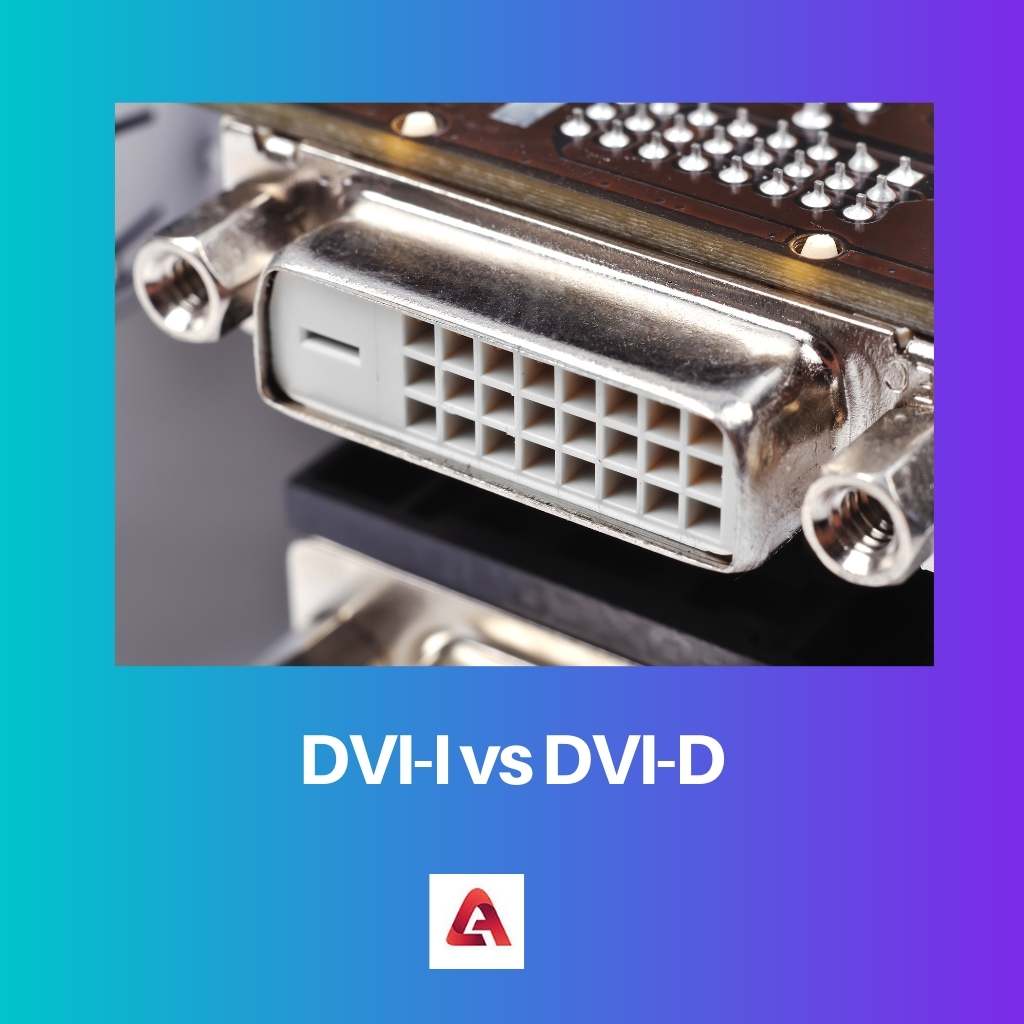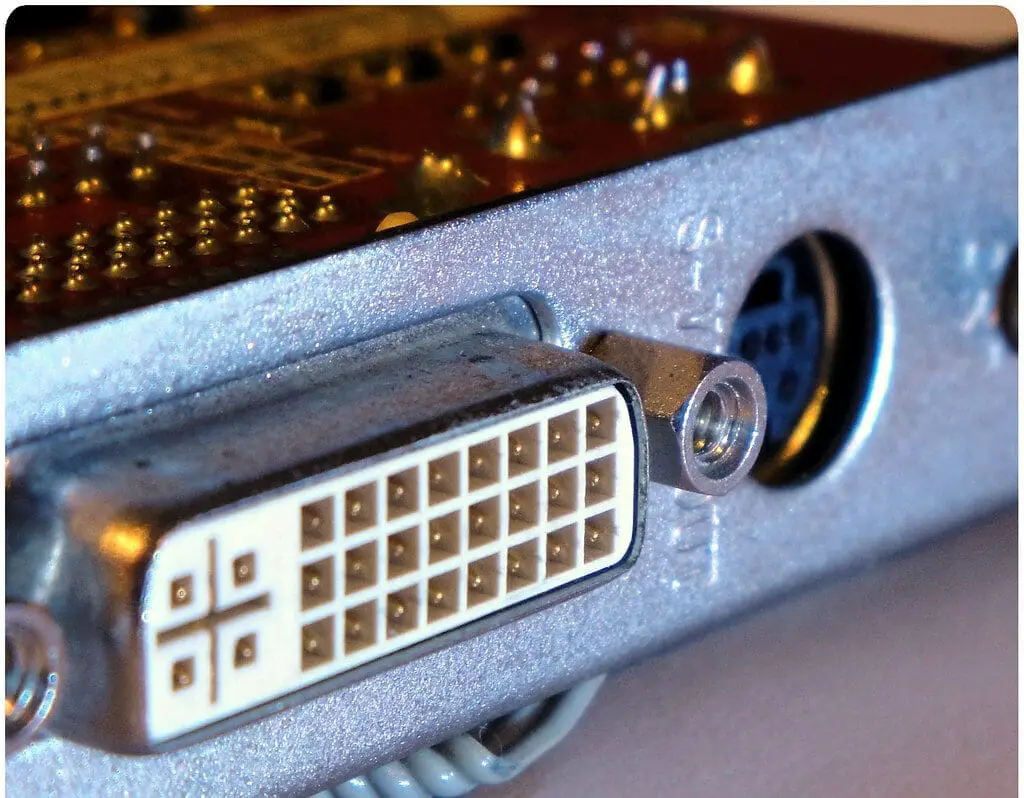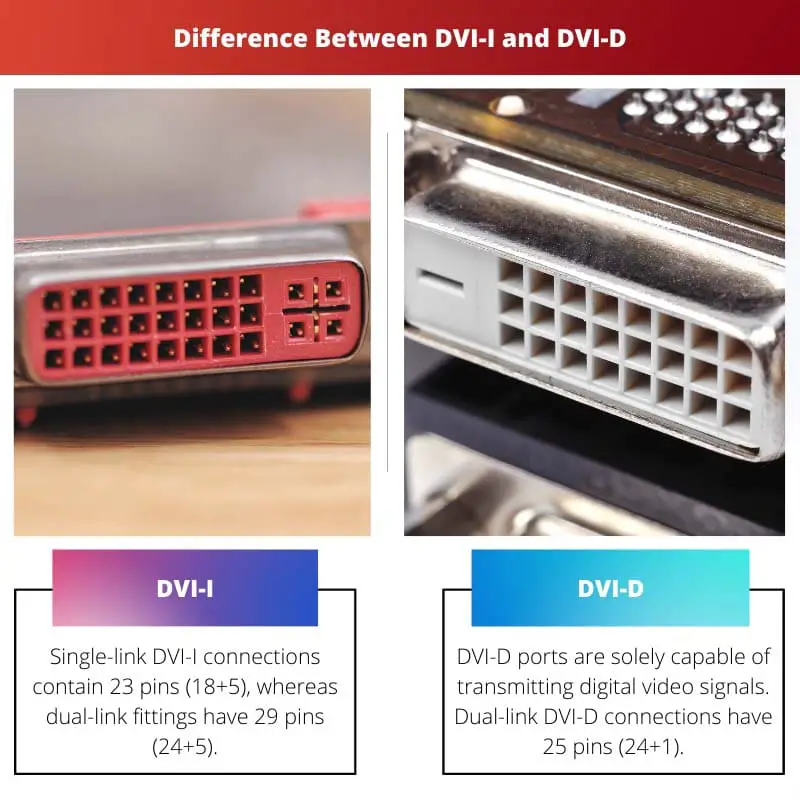The Digital Display Working Group (DDWG) created the Digital Visual Interface (DVI), a graphic display protocol and standard.
The electronic connection connects video codecs and visual display processors to show equipment such as computer screens, televisions, and projectors.
In 1999, the API was created to develop a technical standard for the simple transmission of electronic video material.
Key Takeaways
- DVI-I (Integrated) supports analog and digital signals, while DVI-D (Digital) only supports digital signals.
- DVI-I is more versatile, as it is compatible with VGA and HDMI using adapters, whereas DVI-D is limited to digital connections.
- DVI-D connectors have fewer pins than DVI-I connectors because they do not require pins for analog signals.
DVI-I vs DVI-D
DVI-I is a DVI connector that supports digital and analog signals. It has a larger number of pins (24) compared to DVI-D. DVI-D is a type of DVI connector that only supports digital signals. It has fewer pins (18) compared to DVI-I. DVI-D is used primarily for digital displays.

Single-link DVI-I connections contain 23 pins (18+5), whereas dual-link fittings have 29 pins (24+5). DVI-I connections do not transform analogue and electronic information, but they may accommodate both — but not all currently.
If a graphics chipset, screen, and connection all have DVI-I connectors capable of supporting analogue and electronic signals, only one mode of functioning may be used.
DVI-D ports are solely capable of transmitting digital video signals. Dual-link DVI-D connections have 25 pins (24+1), whereas single-link DVI-D ports have 19 pins (18+1). DVI-D cables are compatible with DVI-D as well as DVI-I connections.
Using an adapter, DVI-D visual signals can be supported by HDMI and DisplayPort ports. However, DVI-D cannot handle the extra capabilities that HDMI and DisplayPort provide, such as synchronized sound and CEC management.
Comparison Table
| Parameters of Comparison | DVI-I | DVI-D |
|---|---|---|
| Transmission | DVI-I connector may transport both digital and analog signals. | A DVI-D connector only carries digital signals. |
| Pins | A DVI-I controller has a significant number of pins. | A DVI-D controller does not have a lot of pins. |
| Displays | LED-backlit LCD monitors and CRT monitors might be used for DVI-I. | Only LED-backlit LCD monitors can be used for DVI-D. |
| Compatibility | VGA devices are DVI-I compatible. | DVI-D is incompatible with VGA devices. |
| Numbers | Single-link DVI-I connections contain 23 pins, whereas dual-link adapters have 29 pins. | Dual-link DVI-D connections have 25 pins, whereas single-link DVI-D connectors have 19 pins. |
What is DVI-I?
DVI-I, which stands for Digital Visual Interface Integrated, is the link or functionality used among displays, laptops, or home entertainment systems.
DVI-I is a digital video outputting network that allows for an LCD or CRT monitor display. DVI-I can accommodate both digital and analogue signals. It will not, however, utilize it all at an equal period.
DVI-I recognizes and selects digital or analogue output based on the attached monitor. DVI-I ports may be readily used in goods such as displays with LED Backlit Lcd screens and for older displays such as CRT displays with the assistance of a DVI to VGA converter.
That is why most people choose graphics cards and processors with DVI-I ports for most projects.
DVI-I connections are used because of their increased capability. DVI-I connections include extra connections due to the participation of enhanced capacity.
The DVI-I connector’s big straight pin is rather broad. Because the DVI-I has extra pins, the male socket of a DVI-I cable cannot attach to a DVI-D female adapter because it lacks slots for the extra pins.
DVI also allows the third sort of technology, the DVI-A, which refers to an interface that only transports analogue signals. DVI-A is not widely used due to VGA’s prominence and success as an analogue display connection technology.

What is DVI-D?
DVI-D is a DVI connection that only handles electronic information. The “D” at the end stands for “digital.” This connection type might be single-link or dual-link.
A single emitter is used in single-link, offering display dimensions of up to 1920 x 1200 and a throughput of 1.65 Gbps. It has an 18-pin connection for energy, data, and clocks and a tall flattened pin for grounding.
The dual-link variant includes an additional broadcaster. The dual-link (DVI-DL) has six extra data ports, raising the image quality capacity to 2560 x 1600 and offering a higher throughput of 2 Gbps.
Because the connection contains all the connections the single user interface needs, the dual-link connection or socket may be utilized with single products.
On the opposite side, a single-link adapter appears to lack a few of the ports or mechanical interconnections necessary by the dual-link connector.
With a few anomalies, such as the lack of capability for signal amplification in DVI-D, DVI-D is essentially consistent with other touchscreen experiences, HDMI.
A converter can be utilized to convert between DVI-D and HDMI. DVI-D and VGA are incompatible. Most digital displays use a DVI-D connector. However, monitors that handle electronic and analogue signals use DVI-D and VGA junction boxes.
Female DVI-D connections will not accept male DVI-A or DVI-I cables because those adapters include the extra 4 analogue pins that DVI-D does not.

Main Differences Between DVI-I and DVI-D
- DVI-D is a DVI connection that solely accepts digital signals, whereas DVI-I accepts electronic and analogue messages.
- DVI-I connections have all of the pins required for a single-link DVI cable. However, DVI-D connectors omit the four pins to transport the analogue signal.
- The DVI-D connector’s tall and flattened pin is shorter than the DVI-I connectors.
- A DVI-D connection can be plugged into a DVI-I port, not the other way around.
- Dual-link DVI-D connections have 25 pins (24+1), but single-link DVI-D connectors have 19 pins (18+1). Single-link DVI-I connections have 23 pins (18+5), whereas dual-link adapters have 29 pins (24+5).

- https://computerstationnation.com/difference-between-hdmi-dvi-vga-and-usb-c/
- https://onlinelibrary.wiley.com/doi/abs/10.1111/j.1365-2796.1993.tb00707.x

This is useful information, I was looking for a detailed comparison.
The comparison provided in the table is really helpful.
Yes, the comparison table effectively highlights the differences between DVI-I and DVI-D.
The post is very well written; the details provided are quite clear.
I completely agree, the details can really help someone who is deciding which type of DVI is applicable for their use.
I found it very helpful as well, especially the explanation about the number of pins in each type of DVI connector.
The information about DVI-A makes this article very comprehensive.
A very informative post, the in-depth explanation of the differences between DVI-I and DVI-D is very helpful.
I am glad that you found the post informative, I agree that the writer has done a great job in making the differences apparent.
The article is overly long and complex, it should be more concise.
I think the complexity is necessary to provide such a detailed analysis.
I believe the depth of the information is essential for anyone who seeks to understand the differences between DVI-I and DVI-D.